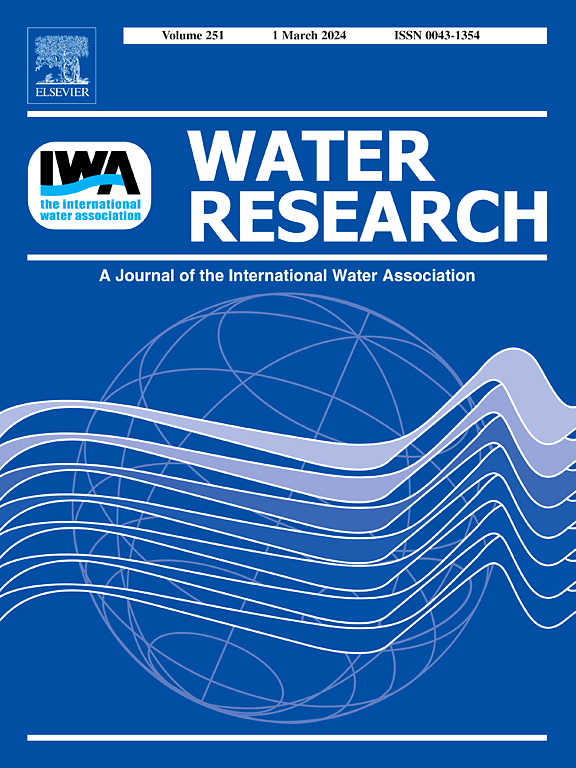Sodium citrate enhances anaerobic fermentation of granular sludge: the multifaceted roles of structure disruption and metabolic regulation
IF 11.4
1区 环境科学与生态学
Q1 ENGINEERING, ENVIRONMENTAL
引用次数: 0
Abstract
Anaerobic fermentation is an efficient approach for recovering organic carbon and other valuable resources from waste sludge, yet its efficiency is constrained by the structural stability of extracellular polymeric substances (EPS), especially for aerobic granular sludge (AGS). Despite the abundant physical-chemical pre-treatment approaches for enhancing EPS dissolution, biocompatible strategies coordinating structural disruption with metabolic regulation remain unexplored. Herein, sodium citrate (SC) was used to enhance the performance of anaerobic fermentation of AGS. The results suggested that SC significantly enhanced the hydrolysis efficiency and volatile fatty acids (VFAs) production of AGS. Despite the direct conversion of SC to acetate, indirect enhancement played more important roles in AGS fermentation. Mechanism analysis indicated that SC disrupted granular sludge structure by chelating Ca2+ and facilitated the release of EPS and hydrolytic enzymes, which was conducive to sludge hydrolysis and acidification. At the level of microbial community, SC facilitated the accumulation of VFAs by enriching the acid-producing microorganisms and inhibiting the acid-consuming microorganisms. Furthermore, SC regulated the genes involved in the direct generation of acetate and pyruvate-centric metabolism, resulting in the massive accumulation of VFAs. Finally, the economic benefits resulting from increased VFA production versus SC costs. Overall, SC enhanced the anaerobic fermentation of AGS by simultaneously affecting EPS structure and regulating metabolism, and this study provided efficient methods for AGS anaerobic treatment.

柠檬酸钠增强颗粒污泥厌氧发酵:结构破坏和代谢调节的多方面作用
厌氧发酵是一种从废污泥中回收有机碳和其他有价值资源的有效方法,但其效率受到胞外聚合物(EPS)结构稳定性的限制,尤其是好氧颗粒污泥(AGS)。尽管有大量的物理化学预处理方法来增强EPS的溶解,但协调结构破坏与代谢调节的生物相容性策略仍未被探索。本文采用柠檬酸钠(SC)提高AGS的厌氧发酵性能。结果表明,SC显著提高了AGS的水解效率和挥发性脂肪酸(VFAs)的生成。除了SC直接转化为乙酸外,间接强化在AGS发酵中起着更重要的作用。机理分析表明,SC通过螯合Ca2+破坏颗粒污泥结构,促进EPS和水解酶的释放,有利于污泥的水解酸化。在微生物群落水平上,SC通过富集产酸微生物和抑制食酸微生物来促进VFAs的积累。此外,SC调节了直接产生醋酸酯和丙酮酸中心代谢的基因,导致VFAs的大量积累。最后,与SC成本相比,VFA产量增加带来的经济效益。综上所述,SC通过同时影响EPS结构和调节代谢来促进AGS的厌氧发酵,本研究为AGS的厌氧处理提供了有效的方法。
本文章由计算机程序翻译,如有差异,请以英文原文为准。
求助全文
约1分钟内获得全文
求助全文
来源期刊

Water Research
环境科学-工程:环境
CiteScore
20.80
自引率
9.40%
发文量
1307
审稿时长
38 days
期刊介绍:
Water Research, along with its open access companion journal Water Research X, serves as a platform for publishing original research papers covering various aspects of the science and technology related to the anthropogenic water cycle, water quality, and its management worldwide. The audience targeted by the journal comprises biologists, chemical engineers, chemists, civil engineers, environmental engineers, limnologists, and microbiologists. The scope of the journal include:
•Treatment processes for water and wastewaters (municipal, agricultural, industrial, and on-site treatment), including resource recovery and residuals management;
•Urban hydrology including sewer systems, stormwater management, and green infrastructure;
•Drinking water treatment and distribution;
•Potable and non-potable water reuse;
•Sanitation, public health, and risk assessment;
•Anaerobic digestion, solid and hazardous waste management, including source characterization and the effects and control of leachates and gaseous emissions;
•Contaminants (chemical, microbial, anthropogenic particles such as nanoparticles or microplastics) and related water quality sensing, monitoring, fate, and assessment;
•Anthropogenic impacts on inland, tidal, coastal and urban waters, focusing on surface and ground waters, and point and non-point sources of pollution;
•Environmental restoration, linked to surface water, groundwater and groundwater remediation;
•Analysis of the interfaces between sediments and water, and between water and atmosphere, focusing specifically on anthropogenic impacts;
•Mathematical modelling, systems analysis, machine learning, and beneficial use of big data related to the anthropogenic water cycle;
•Socio-economic, policy, and regulations studies.
 求助内容:
求助内容: 应助结果提醒方式:
应助结果提醒方式:


